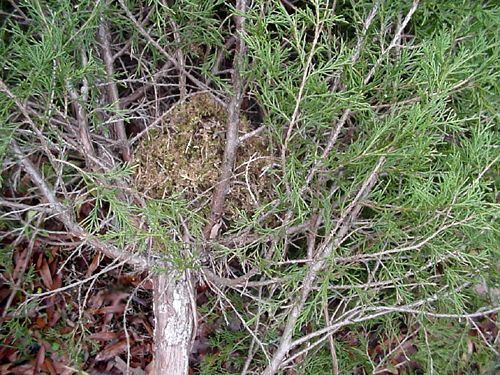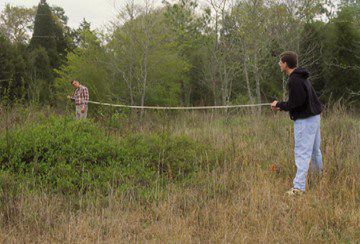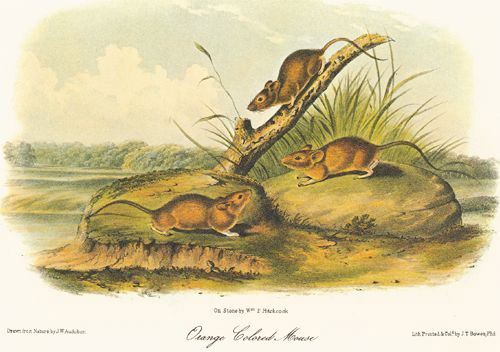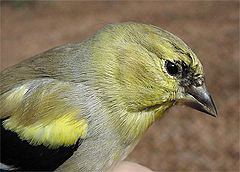|
|
|||
|
THIS WEEK at HILTON POND |
|
During the spring breeding season, we don't spend lots of time seeking out bird nests at Hilton Pond Center. We do, however, make an effort to watch adult birds as they gather nesting material or food, since such birds can unknowingly lead us to their nests. We find a dozen or so nests this way each spring, but when winter arrives and leaves are on the ground, we're still amazed by the numbers of unfound bird nests that become visible on bare tree branches. Although spotting winter nests in deciduous trees is fairly easy, they're hard to find at any time in Eastern Red Cedars. These trees are evergreen and have dense, and prickly foliage that obscures the nests within. If we make an extra effort to look among the cedar needles, we quite often find--especially in a tree near an open area--the loosely constructed stick nest of a pair of Northern Cardinals. Occasionally, there's a much-smaller, grassy, hair-lined nest woven the spring before by Chipping Sparrows.  One day this week our investigation of cedars turned up something quite a bit different--a 10-inch sphere of fresh green moss (above) with a small opening on one side. We did have to part the foliage to see our prize, but after that the moss ball was hard to miss; it was right at eye level and in a somewhat spindly 12-foot cedar with sparse lower branches. Had we never seen this kind of structure, we would have been perplexed, but a few years ago we were fortunate enough to find a similar ball of moss still occupied by its builder--a Golden Mouse, Ochrotomys nuttalli.  Golden Mice take their name from their unique fur color, although juveniles (above) often lack the rich, ocherous shades of the adult. The more-familiar White-footed Mouse, Peromyscus leucopus, sometimes bears pelage of a slightly golden hue, but it always shows a distinct line of separation where the gold joins the white of the belly. The back and belly colors blend together gradually in the Golden Mouse, which is also a tad smaller and has a shorter tail than P. leucopus. Golden Mice are relatively common residents of blackberry/honeysuckle/ greenbrier thickets (below left) and moist woodlands in much of the southeastern and southcentral U.S.; they do not occur north of central Virginia and may be considered threatened or endangered in some localities at the edges of their range. In the mid-1990s, a study by Billy Hilton III showed that of the small mammals at Hilton Pond Center, only Cotton Rats, As Billy's study indicated, Golden Mice are active at night and do not hibernate. Of the North American mice that can climb, the Golden Mouse--with its semi-prehensile tail--may be the most arboreal; sometimes one can be seen at dusk scampering along tree branches and vines 30 feet up. Their spherical nests may be found that high, but more likely are built at ten feet or less above the ground. Golden Mouse nests are used primarily as places to rear the current litter. Even so, there are records of several males collaborating to build and cohabit an oversized tree nest; this "bachelor pad" may have an important role in population dynamics, since some mammalogists have found that a female will not let her mate enter her nest once she has given birth. Golden Mice--inelegantly called the "Orange Colored Mouse" by John James Audubon (below)--come down from trees in colder latitudes and spend the winter in subterranean nests. Regardless, a search of cedar trees in any season may reveal what looks like an incomplete arboreal nest of leaves and small twigs. If these structures are littered with plant parts and droppings, they may be feeding platforms that Golden Mice construct and re-visit after collecting seeds and insects in their cheek pouches. Much less jittery than many native mice species, Golden Mice are so calm that one we encountered on a feeding platform simply stared back for half a minute as we eyeballed it from two feet away.
Even though warmth-seeking White-footed Mice often enter our old farmhouse in winter at Hilton Pond Center, we've never had the honor of hosting a Golden Mouse indoors. These low-strung little rodents would be welcome--but only in the short-term, of course--lest they nibble on our Cheezits and Rice Crispies in the pantry. After admiring them for a while, we'd take these "Little Mice of Gold" back outside and carefully place them in the nearest cedar tree. There they'd likely run along the nearest branch and scurry out of view--perhaps to build another mossy nest while waiting for their next breeding opportunity. If you enjoy "This Week at Hilton Pond," please help Support Hilton Pond Center for Piedmont Natural History. It's painless, and YOU can make a difference! You may wish to consult our Index of all nature topics covered since February 2000. |

 Sigmodon hispidus, were more common than Golden Mice. Billy--at that time a high school student--laid out a 100-meter by 100-meter grid (below right) and live-trapped and released small mammals at night over three consecutive winters. In all, he caught 178 individual mammals of seven species: 115 (80%) Cotton Rats, 31 (31%) Golden Mice, and 23 (13%) White-footed Mice. (We should mention, with some degree of pride, that Billy's dedicated work earned him the honor of representing South Carolina at two International Science and Engineering Fairs, and proved once again that high school students are fully capable of doing original field research.)
Sigmodon hispidus, were more common than Golden Mice. Billy--at that time a high school student--laid out a 100-meter by 100-meter grid (below right) and live-trapped and released small mammals at night over three consecutive winters. In all, he caught 178 individual mammals of seven species: 115 (80%) Cotton Rats, 31 (31%) Golden Mice, and 23 (13%) White-footed Mice. (We should mention, with some degree of pride, that Billy's dedicated work earned him the honor of representing South Carolina at two International Science and Engineering Fairs, and proved once again that high school students are fully capable of doing original field research.) In warmer areas of the Carolinas, the species may even be reproductively active during every month. With a gestation period of four weeks, copulation by the mother immediately after birth, and a distinct possibility for many successive litters over a surviving female's two years of life, it's no wonder there are plenty of local Golden Mice that serve as food items for owls, weasels, and other nocturnal predators.
In warmer areas of the Carolinas, the species may even be reproductively active during every month. With a gestation period of four weeks, copulation by the mother immediately after birth, and a distinct possibility for many successive litters over a surviving female's two years of life, it's no wonder there are plenty of local Golden Mice that serve as food items for owls, weasels, and other nocturnal predators.





